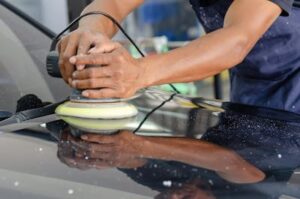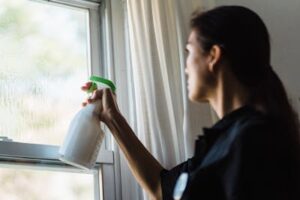Auto Body Pre Paint Cleaner
On auto body painting, a perfect finish is the most important. A common stage that is frequently missed in this entire process would be the pre paint cleaning step. In this blog post, we will go all in one about what are Auto body pre paint cleaner and why its important for you to use it while painting a vehicle or other surface type such information jetting guide which types of pre-paint cleaners available and how do they work best on different surfaces. We will also talk about errors, as well give you some FAQs to make sure all your queries are covered.
How Pre Paint Cleaner for Auto Body Works?
Auto body pre paint cleaner is an advanced formulation of cleaner, used to prepare various surfaces for painting. Which acts as a surface cleaner that can remove dirt, grease, wax and old paint residue to ensure that the new paint will adhere well while providing The PDF Search you for an even smooth finish. A pre paint cleaner must always be used to prevent issues such as peeling, bubbling or the surface from being not uniform. Proper cleaners are key to the success of any auto painting project.
Why is Pre Paint Cleaning Essential?
- Enhance paint adhesion
The proper pretending is to increase the power of your tape. Improper surface cleaning can cause the paint to not adhere, which results in early failure. Since you want the paint to stick well, a smooth base is important for longer lasting colour.
- Surface Preparation
With a clean surface comes with optimal ability to sanding and priming, allowing paint to adhere perfectly. It primes (in your can or out) the area and that is crucial for a good finish in both spots.
- Durability
Cleaning correctly will increase the longevity of your paint and offer protection against nicks, scratches, sun damage etc. Since contaminants, damage the paint in a manner that will have it fail over time.
- Finish quality
A smoother surface means a cleaner finish, and it will look more professional. Paint that is applied to a surface which is not clean and has grease on it will have imperfections, the overall look of this type of paint application could appear patch.
- Affordability
Time is money and spending time on cleaning can save you the same in future. Way to cut those overall costs, fewer repairs and touch-up work absolutely result from a well-prepared surface.
Different types of pre paint cleaners

- Chemical-Based Cleansers
This kind of cleaner displaces grease and oil. They work but must be performed in a secluded place because of the odors. Suitable for heavy soiling, solvent-based cleaning agents penetrate deep into porous surfaces and can dissolve even the toughest contaminants.
- Cleaners
Water-based, kinder to use. They work great for light cleaning and are good for the environment. Water based cleaners may be surfactants which helps to pull up dirt and grease without having the same harsh chemical composition as what is found in solvent base.
- Wipe-On Cleaners
These products are spritzed or wiped on and require minimal effort to use, making them great for quick cleanups. Excellent for smaller jobs or touch-ups when you need a simple-to-use cleaning solution quickly.
- Specialized Cleaners
A number of pre paint cleaners are meant for a particular type of surface, such as plastic or metal. They are engineered for the particular type of contaminant they address and also to do it in such a way as not inhibit adhesion on differing types of paint.
How To Use Auto Body Pre Paint Cleaner

- Collect Supplies
You want to pick your pre paint cleaner, nice clean microfiber towels and possibly a spray bottle. Have lots of cloths available, you’ll need to use clean ones frequently so they don’t reintroduce contaminants.
- Get the Surface Ready
Make sure you are working in a well-ventilated space. For those who are working on a vehicle, likewise park under shade so the sun does not beam down directly. Tip: The cleaner itself might evaporate too quickly in direct sunlight.
- Apply the Cleaner
If you are using a spray cleaner, spritz an ample amount directly onto the surface. How to use: Wipe-on cleaners should be applied through a clean cloth. Try not to apply too liberally as this may lead to pooling and uneven cleaning.
- Clean the Surface
Use a clean microfiber cloth to wipe in circular motion. Be sure to treat all areas, especially around seams and crevices. And do focus on areas that normally gather the most amount of grease or grime like door handles and under the hood.
- Surface Inspection
Post-cleaning, it is extremely important to inspect the surface so you are aware of any remaining contaminants. If needed then repeat the process of cleaning. The stubborn residues may sometimes need to be wiped more than once for complete removal.
- Dry
Make sure the area you washed has dried completely before using primer or any paint. The application of paint onto a wet surface is very important because if the exterior or interior surfaces are damp then its adhesion with the another base and finish will be affected.
Common Mistakes to Avoid
Know When to Skip The Cleaner
For real you should always use a pre paint cleaner, or bad things will happen. While you may give in to the temptation of immediately starting on a painting job, it is an ill-advised this process will not yield the efficient results.
- Wrong Cleaner
Always make sure you get the appropriate type of cleaner to be used on any area in your home. A solvent-based cleaner might damage a plastic surface, at the same time as a mild cleanser may do anything but penetrate heavy grease.
If the surface is wet, not dried properly for of example and when drying time has passed then you apply in on a very fresh coat. Make sure the surface is dry before moving on.
- Soiled Cloths
Always work with fresh and clean microfiber cloths to avoid infecting that surface using the exact same contaminants. Using clean cloths is a must, for dirty ones will erase the benefit of your diligent practice with cleaning.
Ignoring Product Instructions
Each cleaner may have specific usage instructions. Following these guidelines ensures that you’re getting the best performance from the product.
Not only will rushing the process be an inefficient cause, everything is done at one mish-mash effort. Rushing will inevitably cause you to gloss over areas, or the paint won’t stick properly.
FAQs (frequently asked questions)
When should I use Paint Pre Cleaner?
Did you know that using a pre paint cleaner is important every single time, whether its on new construction or maybe touched up. Regular cleaning techniques will provide the desired results every time.
Household Cleaners or can I use household cleaners instead?
This may be limited to just a few household cleaners, as nearly all contain chemicals that can effect the adhesion of paint and should never be used on such objects. For the compatible products, always use auto body painting products.
Are mechanically cleaned interior car plastics safe to use indoors?
Operating the pre paint cleaners in a well-ventilated area will avoid fumes from being… When using indoors (if you have to use inside), wear a respiratory mask and take care of proper ventilation so that harmful vapors are quickly eliminated from the interior.
Should I protect myself?
When using pre paint cleaners it is recommended to wear gloves and goggles due to the harsh chemicals. This should avoid any possible reactions.
Do I have to waiting for the paint?
For painting, make sure that the surface is thoroughly dry after cleaning. Which also makes sure the greatest adhesion & finishing quality
What if I see streaks after cleaning?
Streaks: If you find streaks after the cleaning, that can be done to use a dirty cloth again or not using sufficient amount of cleaner. Then, make sure your garment is clean and add fresh application of cleaner as necessary.
Tips for Optimal Results
- Try on a Small Spot: Before applying to the entire surface, check and test new cleaner first in a small hidden area.
- Sand Surface After you clean, back off any splinters by sanding the surface lightly. This will help make a smoother surface for the paint to stick.
- Clean in Suitable Environment: Temperature controlled important before use. Excessive heat or cold might cause the cleaner to be less effective.
- Safe Storage: Always store your pre-paint cleaner where it will not overheat or freeze or get direct sunlight that can cause evaporation and reduce cleaning power.
- Check the labels: You should check and read a cleaning product to know what that cleaner consists of as well if there are particular precautionary measures you have to take.
Conclusion
In summary, the use an auto body pre paint cleaner is a must before painting. Last step in surface preparation is that surfaces should be cleaned throughout and if past smooth requirements are used ready. Proper prepping will give your the peace of mind to knock it out smoothly and in turn, make you look like a hero! And to reiterate the cleaner your surface, the better paint you will get.
Choosing the correct pre-paint cleaner, using it correctly and not falling into a few common pitfalls will help your auto body painting to be successful. Once you nail this step, too will either professional or a DIY pro painting the surface with ease and get that smooth finish all time. If you want to know more about us than click here:
Difference table of the Content
| Aspect | Description | Benefit |
|---|---|---|
| Purpose | Used to remove contaminants (dirt, grease, wax) before painting | Ensures clean, smooth surface for optimal paint adhesion |
| Types of Cleaners | – Chemical-based: Strong, solvent-based for deep cleaning – Water-based: Eco-friendly, mild for light cleaning – Wipe-on: Quick application for touch-ups – Specialized: Made for specific materials (metal, plastic) |
Allows selection based on cleaning needs and surface type |
| Importance of Use | Prevents issues like paint peeling, bubbling, and poor adhesion | Ensures long-lasting, high-quality paint finish |
| Application Steps | – Collect supplies – Clean surface with pre-paint cleaner – Wipe with microfiber cloth – Inspect and dry surface |
Reduces contamination, ensures even paint application |
| Common Mistakes | – Using wrong cleaner – Applying to a wet surface – Reusing soiled cloths – Ignoring instructions |
Prevents paint failures and maintains surface prep quality |
| Protective Measures | Gloves, goggles, and ventilation when handling chemicals | Ensures safety during cleaning |
| Cost Efficiency | Saves time on future repairs and touch-ups | Reduces long-term costs by preventing paint failures |
| FAQs | Covers optimal use timing, safety tips, and handling indoor use | Provides guidance on proper usage for best results |





One thought on “The Ultimate Guide to Auto Body Pre Paint Cleaner”